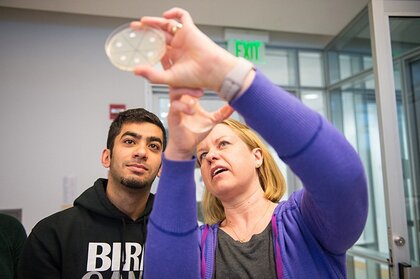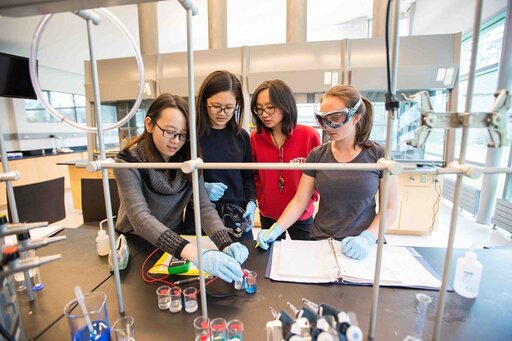Because our definition emphasizes skills students will need at some future points in their lives, our pedagogy emphasizes hands-on, realistic problem-solving situations. We also emphasize repeated practice, which provides the opportunity for improvement and transfer.
We cannot prepare students for every situation, but we can give them repeated opportunities to:
A fundamental premise of our approach is that formal science education constitutes only a small fraction of most people’s lives, so that most of what they learn in school will need to be transferred to new situations. For this reason, we cannot overstate the importance of giving students time and opportunities to practice the active transfer of what they are learning in the classroom. We assume that students who have experience practicing the transfer of skills and knowledge from one context to another will be better able to repeat this challenge outside the boundaries of the classroom.
We cannot prepare students for every situation, but we can give them repeated opportunities to:
- Respond to real-world problems,
- Explore solutions to problems about which there is conflicting scientific evidence,
- Practice transferring their skills and knowledge from one context to another.
A fundamental premise of our approach is that formal science education constitutes only a small fraction of most people’s lives, so that most of what they learn in school will need to be transferred to new situations. For this reason, we cannot overstate the importance of giving students time and opportunities to practice the active transfer of what they are learning in the classroom. We assume that students who have experience practicing the transfer of skills and knowledge from one context to another will be better able to repeat this challenge outside the boundaries of the classroom.
TRANSFER
Transfer is a challenging concept to explore, but we are convinced that any serious approach to teaching science to non-majors must grapple with this aspect of learning. Here, we provide a selection of foundational and practical readings about transfer.
Teaching for Transfer
|
Teaching basic science to optimize transfer
|
|
In this broad overview, the authors outline major ideas about the transfer of learning and provide a toolkit of foundational concepts, including near versus far transfer, and automatic versus mindful transfer.
|
This very useful website provides succinct and practical tips for how to teach to help your students achieve transfer.
|
Education for Life and Work: Developing Transferable Knowledge and Skills in the 21st Century
NATIONAL ACADEMY OF SCIENCES 2012
This thorough report from the U.S. National Academy of Sciences highlights the importance of “deeper learning” in 21st century education and the central role that transfer plays in this learning, with a specific chapter on teaching and assessing transfer. Free download with registration.
OUR
|
"Beyond transfer, the issue of pedagogy is crucial. If your goal is for students to be able to DO something, then the pedagogy must include repeated practice actually doing that thing! No matter how good your definition is, if you’re just going to lecture at them, you are almost certainly not achieving your goals."
– Phil Pardi, Bard College |
More generally, it seems clear to us that the approach to teaching science to non-majors has elements that are—or should be—distinct from traditional approaches to teaching majors. Here, we provide links to resources for some key elements of teaching science to these students:
Vision Learning
The real prize in this wide-ranging website, which features online readings and simple quizzes on topics from many scientific disciplines, is the section on the Process of Science, which covers important topics for non-scientists such as Ethics in Science and Scientific Institutions that are rarely addressed elsewhere.
|
NCCSTS Case Studies
This website provides a wide range of polished case studies for STEM fields, with some of the most appropriate for non-majors including “The Last Spruce Grove” and “Kermit to Kermette” because of their authentic focus on real-world situations. Access to instructor keys requires a paid subscription, but student materials are useful on their own.
|
Sleeping Mountain Scenario
This activity, developed for an introductory geology course, provides an excellent example of how role-playing can provide students with opportunities to connect the science they’re learning to a real world situation with no easy answers, and stakeholders whose points of view range far beyond science.
Gapminder
An inexhaustible, free graphical resource with unlimited potential for use in STEM classrooms, inviting students to connect ideas from across disciplines and through time, and with pointers to supplemental TED videos by gapminder’s developer, Hans Rosling
Profiles of scientists
Developed by NOVA for public television, this site brings science to life by providing videos of diverse scientists who have interesting biographies, including Mae Jamison, an astronaut and dancer who appeared in Star Trek, and James Levine, an obesity research and slam poetry champion.
BioQuest Numb3r5 Count!
This site provides a host of data-oriented resources. The real gem is the resource on basic statistics, which provides a wealth of interactive activities for developing foundational skills in interpreting statistics and graphs.
Biointeractive from HHMI
This rich collection of free, sortable, and ratable online biology materials offers short films, animations, teacher guides, and lectures on topics as wide-ranging as skin color and mapping genes to traits in dogs
How Science Works
This video, produced by the California Academy of Sciences, uses a discovery about spiders to challenge the conventional and simplistic view of how science is done, providing a wonderful supplement to the excellent, rich, online materials on understanding science from the University of California Museum of Paleontology.
|
Life cycle of science information
Through quiz questions, simple activities, and short online readings, this web tutorial provides an overview of how science is done, with a focus on sources of scientific information, including an explanation of gray literature, and differences between book chapters and primary papers.
Worldmapper
This collection of world maps, where countries are re-sized on each map according to the subject of interest, can be explored through broad categories (e.g. health, energy, disease, environment, resources) that provide wonderful entry points for exploring scientific topics.
NOVA virtual labs
Developed by NOVA, this site provides a suite of engaging, hands-on, interactive activities that feature evolution, cybersecurity, sunspots, sustainable energy, clouds, and RNA.
Virtual labs from HHMI
These well-produced virtual laboratories address a variety of biological topics with societal relevance, including identifying bacteria, quantifying evolution, creating transgenic flies, and observing neuronal activity.
Science in the classroom
This extensive collection of papers published in Science is a great resource for teaching about scientific papers because it provides automated annotations that allow students to easily highlight different components of the text, including references to prior work and policy implications.
Using PBL to investigate scientific claims
Brickman et al. 2012 describe an approach to having students work in teams to investigate scientific claims in the media, a useful and transferable skill.
|
Here, we offer resources on the teaching of science more generally.
Pedagogy in action
This site provides a rich catalog of resources about student-centered teaching, with brief descriptions of each technique so that you can easily determine if it is suited to your purposes.
Resources for problem-based learning
From the University of Delaware’s site on problem-based learning, this page provides access to real syllabi and sample exams from courses that make heavy use of problem-based learning and case studies.
Reacting to the past
Primarily designed for the teaching of history, this collection from Barnard College requires students to investigate a historical incident from many perspectives and then to participate in a role-play of the events, which can take as much time as a semester or as little as a few days of class. Several of the events have scientific themes, including one on acid rain in Europe in the 1980s, and another on a 1991 challenge to the USDA's food pyramid. Downloading materials requires institutional or individual membership, which is on a sliding scale.
|
Videos of alternative teaching strategies in action
These videos, developed by the Carl Wieman Science Education Initiative at the University of British Columbia, provide real examples of alternative pedagogies in practice, including the use of worksheets, clickers, and flipped classes.
Chapter from 'How People Learn: Brain, Mind, Experience, and School: Expanded Edition'
This chapter from a book by the U.S. National Academies Press provides fascinating examples of how experts differ from novices in their understanding, and how this can affect teaching.
Twenty tips for interpreting scientific claims
In this paper from Nature, Sutherland et al. 2013 present a list of twenty tips for policy-makers to interpret scientific claims, which are useful for non-majors as well.
iBiology Active Learning videos
By providing motivation, examples, and support, the videos on this site support instructors making the shift towards student-centered learning using evidence-based pedagogies.
|
DID YOU KNOW THAT:
- According to this 2015 report from the Pew Research Center, which is summarized online here, 70% of American adults are able to correctly answer 8 of 12 simple questions about science, as determined by a multiple-choice quiz. Is that science literacy?
- Science For All Americans, an influential report from the American Association for the Advancement of Science, outlines a vision of the purpose and value of K-12 science education for all, not just future scientists, and provides an exhaustive characterization of science literacy.






